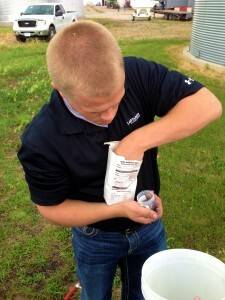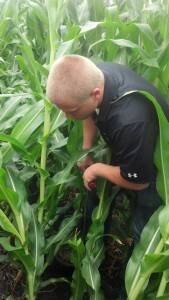Sample Soils Now to Increase Yield in 2014
Post-harvest is the perfect time to take soil samples. As part of his summer internship, Iowa State University student Kellen Sunkten prepared the following article to explain what a soil test is and why it’s so important.
 What a soil test is: A soil test is a process of testing soil to see how available nutrients are to a plant. Nutrients are chemically removed from the soil and measured. The information retained from soil tests is then used to determine how much fertilizer needs to be applied to a field and what nutrient deficiencies must be addressed. Soil pH, humic matter and exchangeable acidity are also measured to determine how much, if any, lime needs to be applied.
What a soil test is: A soil test is a process of testing soil to see how available nutrients are to a plant. Nutrients are chemically removed from the soil and measured. The information retained from soil tests is then used to determine how much fertilizer needs to be applied to a field and what nutrient deficiencies must be addressed. Soil pH, humic matter and exchangeable acidity are also measured to determine how much, if any, lime needs to be applied.
Why soil tests are important: Soil tests are important to determine the right amount of fertilizer. If too little fertilizer is applied, it can cause growth deficiencies in crops. If too much fertilizer applied, it’s a financial waste for farmers and runoff becomes an issue. Soil samples can help farmers develop a plan for maximum crop growth and efficiency.
When sampling should be done: Soil samples should not be taken within 8 weeks of previous fertilizer application. Soil sampling should be done as early as possible before planting season to provide for enough time to make fertilizer decisions and have them take effect once applied. It’s important to apply lime early, if needed, so it has enough time to alter the pH of the soil before planting takes place.
 How to take a soil sample: Use a soil probe and a spade or a hand trowel to dig a V–shaped hole that is 6 to 8 inches below the soilsurface. Then take a 1-inch slab off of the side of the hole and put it in a clean plastic bucket or bag. Take 15 to 20 surface samples per 40 acres. As you take these samples, put them into the same bucket or bag. When you are finished collecting your samples, mix them all together very well. Then pull one sample from the mixture for the soil testing lab. When collecting samples, it’s very important not to use brass, bronze or galvanized tools because they will contaminate your samples with copper and zinc. Deliver samples to the testing lab within 48 hours of when they are pulled, otherwise bacterial movement will skew the results.
How to take a soil sample: Use a soil probe and a spade or a hand trowel to dig a V–shaped hole that is 6 to 8 inches below the soilsurface. Then take a 1-inch slab off of the side of the hole and put it in a clean plastic bucket or bag. Take 15 to 20 surface samples per 40 acres. As you take these samples, put them into the same bucket or bag. When you are finished collecting your samples, mix them all together very well. Then pull one sample from the mixture for the soil testing lab. When collecting samples, it’s very important not to use brass, bronze or galvanized tools because they will contaminate your samples with copper and zinc. Deliver samples to the testing lab within 48 hours of when they are pulled, otherwise bacterial movement will skew the results.
Collecting soil samples now also can (1) help determine whether soybean cyst nematodes (SCN) are present and (2) buy time to develop management strategies, controlling nematode numbers in infested fields.
Fall grid samples are also useful for those farmers who wish to enroll in Latham’s hallmark Seed-2-Soil® program. Seed-2-Soil helps simplify the crop planning and seed selection processes plus maximize overall yield potential. It begins with a discussion with a farmer and his Latham® seed rep about all the variables that go into your farming practices each year. Then a scientific computer program helps fit the right seed to the field. Research has shown that correct product placement leads to a 3-7% yield improvement.
Contact Latham Hi-Tech Seeds today and harness the power of Seed-2-Soil and fall soil sampling!